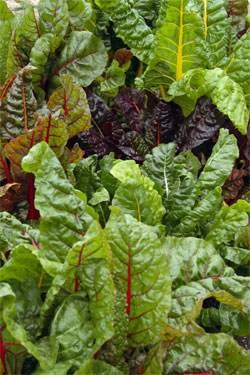Swiss Chard – Too Pretty to Eat?

Swiss chard is a cool-season vegetable that’s closely related to beets. That explains the similarity in their leaves and their looks. Of course, chard is grown for its foliage, while beets are grown primarily for roots. (Many people do use their early-season beet thinnings as leafy amendments to their garden salads.)
But, for the purpose of this discussion, we’re going to talk about the types of Swiss chard that we grow primarily for their good looks. The variety ‘Rhubarb’ came first, decades ago. Its leaves are deep and rich red, and many of us included it in our landscapes almost every late winter and early spring (still do).
More recently, however, ornamental Swiss chard has become even more handsome. Mixes like ‘Bright Lights’ put vivid shades of red, pink, lavender and white alongside the large leaves’ normal dark green color. The plants grow to 15 to 18 inches tall, and they should be massed on 8- to 10-inch centers.
You can use Swiss chard as a backdrop to pansies, tulips, daffodils and other spring color plants, or you can mass it in beds alongside your shrubs and groundcovers. It’s also an outstanding container plant, and that’s where ‘Bright Lights’ really performs. Its bouquet of rich colors sparkles in the warming days of February. Best of all, it will flourish in both sun and part shade, where most annual flowers require almost full sun. All it asks is a ready supply of nitrogen, ample water to keep it growing briskly, and perhaps a little protection should the weather turn really cold (mid-20s or colder).
Local nurseries have good supplies of ornamental Swiss chard right now. Give it a try. Like the rest of us, you’ll probably never be without it again.
